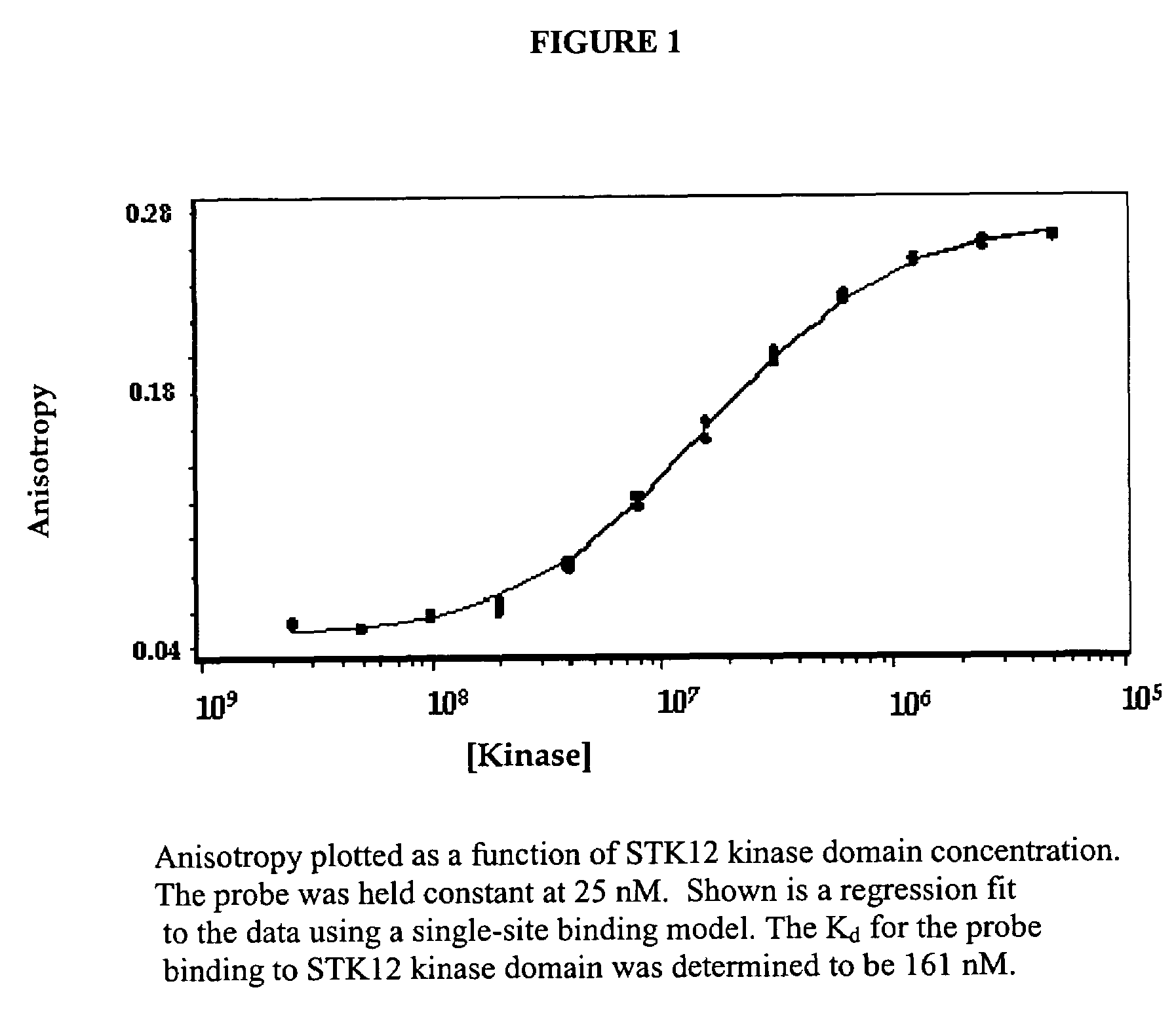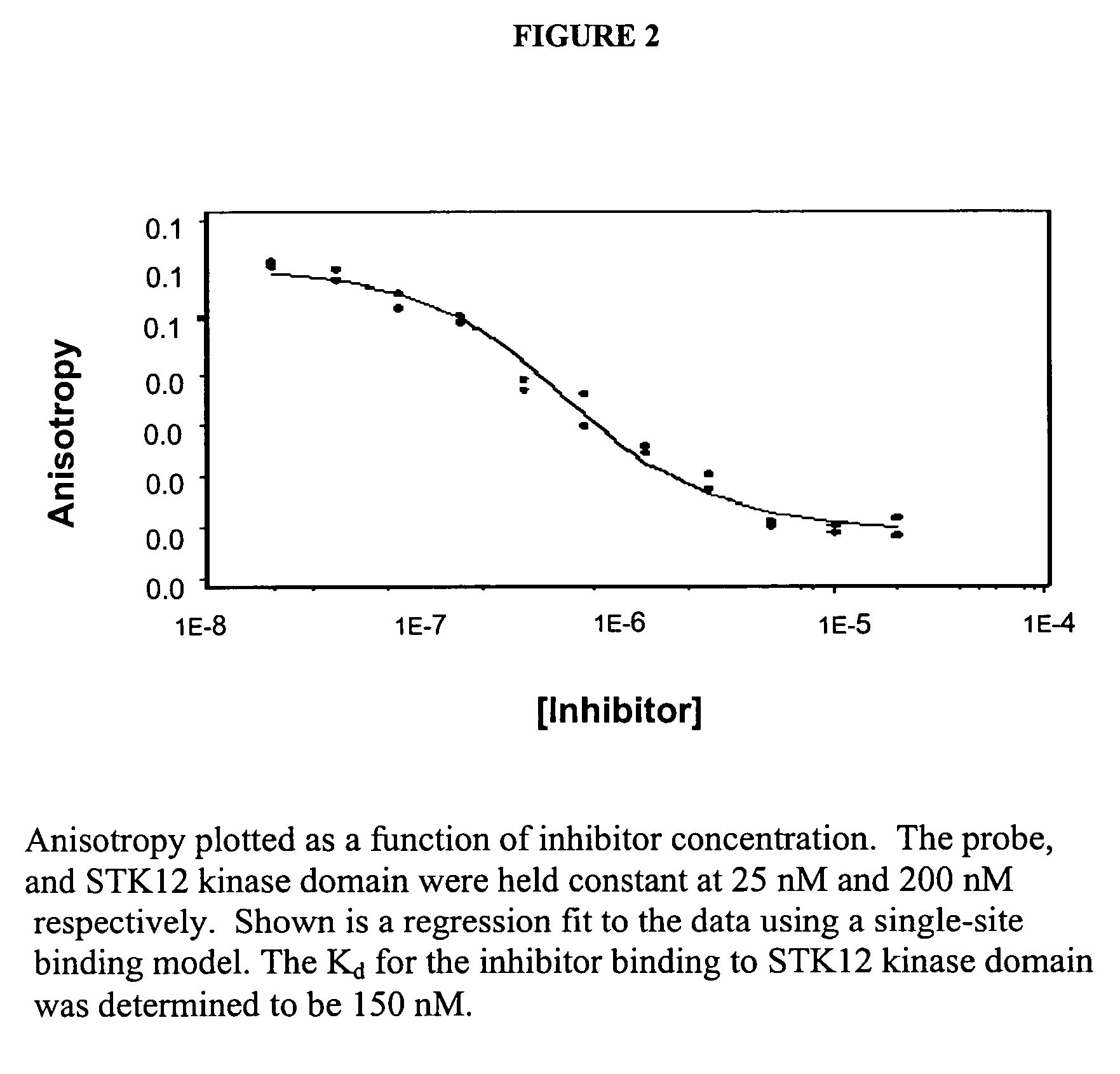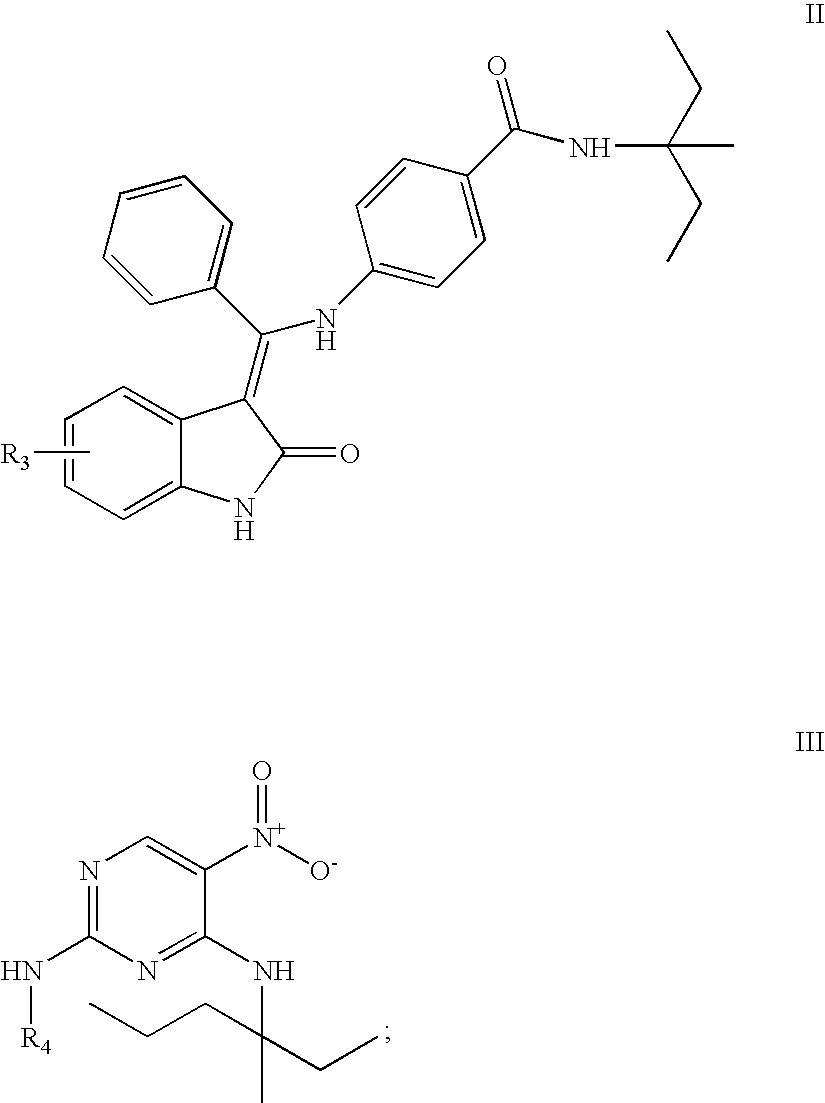Fluorescent probes for use in protein kinase inhibitor binding assay
a technology of protein kinase inhibitor and fluorescent probe, which is applied in the direction of peptides, biological material analysis, biological testing, etc., can solve the problems of high difficulty in adapting the assay into a high throughput format, high difficulty in obtaining assay results, and inability to detect the affinity of compounds, etc., to achieve the effect of saving institutes, reducing assay development time and reagent cos
- Summary
- Abstract
- Description
- Claims
- Application Information
AI Technical Summary
Benefits of technology
Problems solved by technology
Method used
Image
Examples
example 1
Synthesis of 6-(2,7-difluoro-6-hydroxy-3-oxo-3H-xanthen-9-yl)-N-{6-[4-({[2-oxo-1,2-dihydro-indol-(3Z)-ylidene]-phenyl-methyl}-amino)-benzoylamino]-hexyl}-isophtalamic acid (Method A) (Comp. A)
[0091]
[0092]p-Nitrobenzoic acid (500 mg, 2.99 mmol), N-Boc-hexanediame (834 mg, 3.3 mmol), 1-(3-dimethylaminopropyl)-3-ethylcarbodiimide hydrochloride (EDC) (699 mg, 3.65 mmol), and 1-hydroxybenzotriazole hydrate (HOBT) (493 mg, 3.65 mL) were combined in dicloromethane (15 mL) and stirred at ambient temperature for 16 hours. The reaction was diluted with EtOAc (50 mL), washed with water, saturated sodium bicarbonate, and brine. The organic layer was dried over magnesium sulfate and filtered. The organic layer was concentrated by rotary evaporation to collect 1.01 g of [6-(4-nitro-benzoylamino)-hexyl]-carbamic acid tert-butyl ester as a white solid (92% yield).
[0093]The above amide (265 mg, 0.750 mmol) was dissolved in EtOH (25 mL). The reaction mixture was charged with ammonium formate (500 mg)...
example 2
Synthesis of 6-(2,7-difluoro-6-hydroxy-3-oxo-3H-xanthen-9-yl)-N-[6-(5-nitro-2-phenylamino-pyrimidin-4-ylamino)-hexyl]-isophthalamic acid (Method B)(Compound G)
[0102]
[0103](5-Nitro-4-thiocyanato-pyrimidin-2-yl)-phenyl-amine (85 mg, 0.311 mmol) was dissolved in dichloromethane (3 mL). Hexanediamine was added to the reaction and the mixture was shaken for 16 hours at ambient temperature. The reaction mixture was loaded directly onto a flash chromatography column (silica gel) and eluted with a dichloromethane, MeOH and ammonium hydroxide gradient. N4-(6-Amino-hexyl)-5-nitro-N2-phenyl-pyrimidine-2,4-diamine (80 mg, 78% yield) was isolated as a yellow solid. The above diamine (5 mg, 0.01 mmol) and Oregon green 488 carboxylic acid succinimidyl ester “5-isomer” (5 mg, 0.01 mmol) were dissolved in DMF (1 mL) and shaken for 16 hours at ambient temperature. The reaction was concentrated by rotary evaporation under high vacuum. The residue was loaded onto a preparative TLC plate and eluted with...
example 3
Binding Assay for Inhibitors of STK12 Kinase Domain
Step One: Characterization of the Fluorescent Probe
[0109]An absorbance spectrum is first evaluated for each probe. The excitation and emission spectra are then measured in order to identify the appropriate excitation and emission wavelengths for detecting the probe. An example of such a probe is 6-(2,7-difluoro-6-hydroxy-3-oxo-3H-xanthen-9-yl)-N-[6-(5-nitro-2-phenylamino-pyrimidin-4-ylamino)-hexyl]-isophthalamic acid where the excitation and emission maxima are 496 nm and 524 nm, respectively. These fluorescence spectra were measured on an SLM-8100 fluorimeter with the probe dissolved in an assay buffer (50 mM HEPES, pH 7.4, 100 mM NaCl, 5 mM MgCl2 5% Glycerol, 200 mM TCEP and 0.01% (w / v) CHAPS, 2% DMSO).
[0110]The affinity of the probe for STK12 kinase domain was then determined in a titration experiment. The polarization assay is carried out in Corning Costar NBS 96-well solid black flat bottom plates. In this example, an LJL Analy...
PUM
| Property | Measurement | Unit |
|---|---|---|
| wavelength | aaaaa | aaaaa |
| temperature | aaaaa | aaaaa |
| temperature | aaaaa | aaaaa |
Abstract
Description
Claims
Application Information
 Login to View More
Login to View More - R&D
- Intellectual Property
- Life Sciences
- Materials
- Tech Scout
- Unparalleled Data Quality
- Higher Quality Content
- 60% Fewer Hallucinations
Browse by: Latest US Patents, China's latest patents, Technical Efficacy Thesaurus, Application Domain, Technology Topic, Popular Technical Reports.
© 2025 PatSnap. All rights reserved.Legal|Privacy policy|Modern Slavery Act Transparency Statement|Sitemap|About US| Contact US: help@patsnap.com



